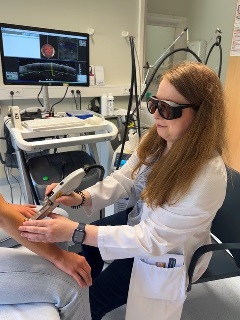Clinical study uses optical coherence tomography to investigate the effectiveness of pulsed dye laser (PDL) versus Nd:YAG laser in the treatment of vascular skin lesions.

Wausau, WI (July 12, 2023) – Dynamic optical coherence tomography (D‐OCT) was introduced as an innovative follow‐up tool for the evaluation of blood flow within superficial vessels and allows visualization of morphological changes of the vasculature in vivo. This study used D-OCT to evaluate blood flow and vessel morphology in the follow‐up of telangiectasias, spider veins, and cherry angiomas, treated with laser therapy.
The clinical report, led by Sandra Schuh, MD, MSc, FEBDV, is titled, “How efficient is laser therapy for telangiectasias, spider veins, and cherry angiomas? —A study using dynamic optical coherence tomography” The report, published in Lasers in Surgery and Medicine (LSM), the official journal of the American Society for Laser Medicine and Surgery, Inc. (ASLMS), was selected as the July 2023 Editor’s Choice.
“We always wanted to know how deep and how effective our lasers really work on vascular lesions, since this was unknown before our study,” said Schuh. “This was the reason why we started to investigate the effectiveness of pulsed dye laser versus Nd:YAG laser in the treatment of telangiectasias, spider veins, and cherry angiomas. We also wanted to demonstrate a possible treatment benefit comparing both laser types.”
The study found that both laser types are suitable options for the treatment of vascular skin lesions, with the most significant effect on cherry angiomas. PDL shows better results treating smaller vessels in upper skin regions, in comparison to Nd:YAG laser, achieving better results on deeper vessels, like spider veins. Using the applied laser settings, there was no statistically significant effect on telangiectasias. D-OCT visualization of laser effects can potentially be used to make therapy more effective by choosing the more optimal laser with the best settings.
Dr. Sandra Schuh completed her Master of Science in Dermoscopy and Preventive Dermatooncology in Graz, Austria in August of 2022. She is currently a consultant at the Department of Dermatology and Allergology at the University Hospital Augsburg, Germany, and teaching and research coordinator of the clinic. She will begin her Master of Medical Education in Heidelberg in September of 2023.
Editor’s Choice is an exclusive article published in LSM, the official journal of the ASLMS. View the complete manuscript.
The American Society for Laser Medicine and Surgery, Inc. (ASLMS) is the largest multidisciplinary professional organization dedicated to the development and application of lasers and related technology for health care applications. ASLMS promotes excellence in patient care by advancing biomedical application of lasers and other related technologies worldwide. ASLMS membership includes physicians, surgeons, nurses, and allied health professionals representing multiple specialties, physicists involved in product development, biomedical engineers, biologists, industry representatives and manufacturers. For more information, visit aslms.org.